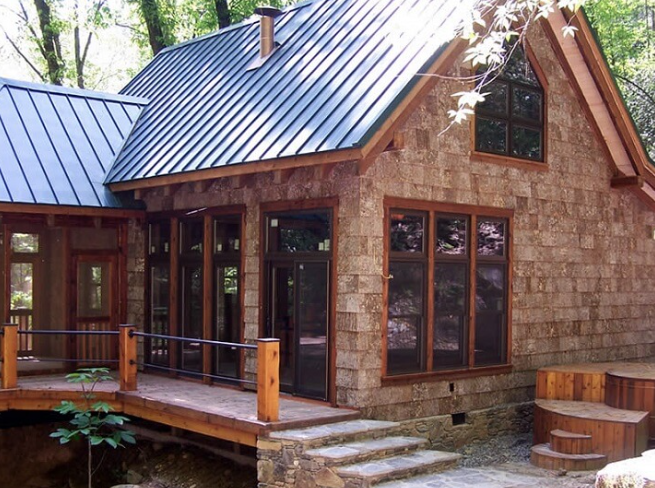Eco-friendly house building materials based on waste

Many people who're going down the self-build route have eco-friendliness at the heart of their project. They want to use sustainable building materials, many of which are derived from waste, and be energy self-sufficient, which means embracing solar panels and ground-source heat pumps. Pictured above: house clad with bark, known as bark siding
Newspaperwood
Most of us recycle old newspapers, but did you know they can also be made into building materials? Newspapers are being combined with glue and compressed into thin layers and given a woo- like texture that can be used in various applications in home building.
Recycled cork
Cork from wine bottles is being collected and made into useful products such as flooring tiles and panels for ceilings, which have the added bonus of absorbing sound. Cork is super eco, recycled cork is super super eco!
Recycled glass tiles
Look out for recycled glass tiles for bathroom and kitchen splashbacks. Companies made tiles using a variety of waste glass, whether it's drink bottles or old panels of window glass sourced from reclamation yards.
Bark siding
Did you know that tree bark is a very durable and sustainable choice for cladding the outside of your house? Eco-friendly companies have been giving tree bark a new life by turning into a natural siding. It's widely used in rural America and is gaining traction here in the UK as a cladding material.
Recycled steel
Steel used in the UK contains a percentage of recycled content (as much as 40 per cent) but you can order fully recycled steel for a framing or structural element in your project. A lot of energy is needed to produce steel but it is very hard-wearing and durable and of course it's recyclable.
Ashcrete
Ashcrete is a concrete substitute that comes in powder form, which is mixed with water. It's not yet widely used for residential construction but that could change in the coming years. Companies have developed the technology to recycle and transform Municipal Solid Waste (MSW) combustor ash into a safe and beneficial precast structure, turning a waste stream into a 100 per cent sustainable material. Ashcrete contributes to a circular economy.
Recycled plastic
Recycled plastic is finding its way into building blocks and insulation. Again, it's early days but recycled plastic bricks could become a major product in housesbuilding in years to come
Enviroboards
Enviroboard is made to be environmentally-friendly - it's non-toxic, odourless, and acts as a repellant against fungus and pests. The chemical makeup of the product means it can also be disposed of via landfill with no risk of harmful emissions or damage to the environment. It's made using waste materials such as sawdust and waste fibre from agricultural plants and is constructed using magnesium oxide reinforced with a fibreglass mesh. This means it's highly resistant to moisture, mold and mildew, and is perfect forrooms that tend to be damp and humid. It's also good for internal partition walls and ceilings, roofing, eaves and gables. The surface of enviroboard has strong binding properties, so it's suitable for different paint finishes and direct wallpapering.
Recycled pavement
Materials such as recycled glass bottles and different types of stone aggregate can be used for sidewalks and driveways.
Recycled glass worktops
Recycled glass fragments held in bio-resins make blocks that can be cut and used as worktops in kitchens. It's quite an expensive material but one that's worth the investment as it's virtually indestructible.
Hazardous materials
One thing to note is that when dealing with waste from building projects, most professional rubbish clearance companies will not collect hazardous materials from their client. This means you have to figure out on your own how to deal with any hazardous materials you may have left over after your building project has been completed.